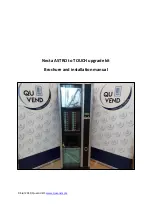
e-STUDIO170F Dialing and Communication Procedure
January 2005 © TOSHIBA TEC
9 - 12
9.3
High-speed Transmission Procedure
The V.34 modem recommended by ITU-T (Max. transmission rate: 33.6 Kbps) is used. Therefore, the
transmission time of the image data is cut substantially when compared to conventional model.
9.3.1
V.8/V.34 procedure
[ 1 ] Outline
• V.8 is performed as a start up procedure to switch to V.34. V.8 can connect an existing facsimile
machine to equipment using data modem or other V series modems. The V.34 modem includes a
modem circuit which can also be connected to the previously recommended modems. Therefore, it
is upwardly compatible.
• The new techniques such as the pre-emphasis techniques *1 and the probing techniques *2, are
fully used. Pre-emphasis techniques not only make the speed of modulation method high, but also
gain the S/N ratio. Probing techniques measure the line characteristics and optimize the modem for
the line state. Therefore, these techniques do not simply speeding-up transmission momentarily, but
do so at the average level when the data transmission is actually performed.
• For V.8 and the pre/post-fax transmission for V.34, the procedure is speeded up by full duplex com-
munication.
• The following 14 types of image transmission speed *3 are available:
33.6 Kbps /31.2 Kbps /28.8 Kbps /26.4 Kbps /24.0 Kbps /21.6 Kbps /19.2 Kbps /16.8 Kbps /
14.4 Kbps /12.0 Kbps /9.6 Kbps /7.2 Kbps /4.8 Kbps /2.4 Kbps
• The modulating speed (baud rate) *4 can be selected from 2400, 3000, 3200 symbol/sec (manda-
tory), or 2743, 2800, 3429 symbol/sec (option). The data rate can be set more accurately than the
conventional modem.
Notes:
1. In the V.34 procedure, ECM is used. If the ECM transmission/reception of user data is set to
“Not performed”, the V.8 procedure is not performed. Therefore, the procedure does not
switch to V.34, and V.17 or the prior, is selected.
2. Also when the transmission/reception speed is set to 14.4 Kbps or less, the V.8 procedure is
not performed, and V.17 or the prior, is selected.
3. To switch to the V.8/V.34 procedure after starting V.21 procedure (Refer to
P.9-20 "[ 3-1 ]
Late start").
4. After the V.34 procedure starts, fallback is performed in the V.34 procedure. However, fallback
for V.17 mode or before is not performed.
*1: A signal is sent by raising the output level in the high-frequency band - in which the noise is rela-
tively loud.
*2: The tone called “Probing Tone” is sent. The receiver measures the line characteristics.
*3: In the ITU-T Recommendation, it is described as “data rate”. “Image transmission speed” is the
same as “data rate”.
*4: In the ITU-T Recommendation, it is described as “symbol speed”. “Symbol rate”, “Modulating
speed”, and “Baud rate” have the same meaning. This machine cannot use the speed of “2743
symbol/sec”.
Содержание ESTUDIO170F
Страница 1: ...SERVICE MANUAL PLAIN PAPER FACSIMILE e STUDIO170F File No SME04002900 R04102171300 TTEC Ver01_2005 05 ...
Страница 2: ... 2005 TOSHIBA TEC CORPORATION All rights reserved ...
Страница 192: ...e STUDIO170F Function Settings January 2005 TOSHIBA TEC 4 132 ...
Страница 214: ...e STUDIO170F Mechanical Description January 2005 TOSHIBA TEC 5 22 ...
Страница 308: ...e STUDIO170F Circuit Description January 2005 TOSHIBA TEC 7 78 ...
Страница 372: ...e STUDIO170F Removal Replacement Adjustment January 2005 TOSHIBA TEC 8 64 ...
Страница 490: ...e STUDIO170F Appendix January 2005 TOSHIBA TEC 12 8 ...
Страница 491: ......
Страница 492: ......
















































